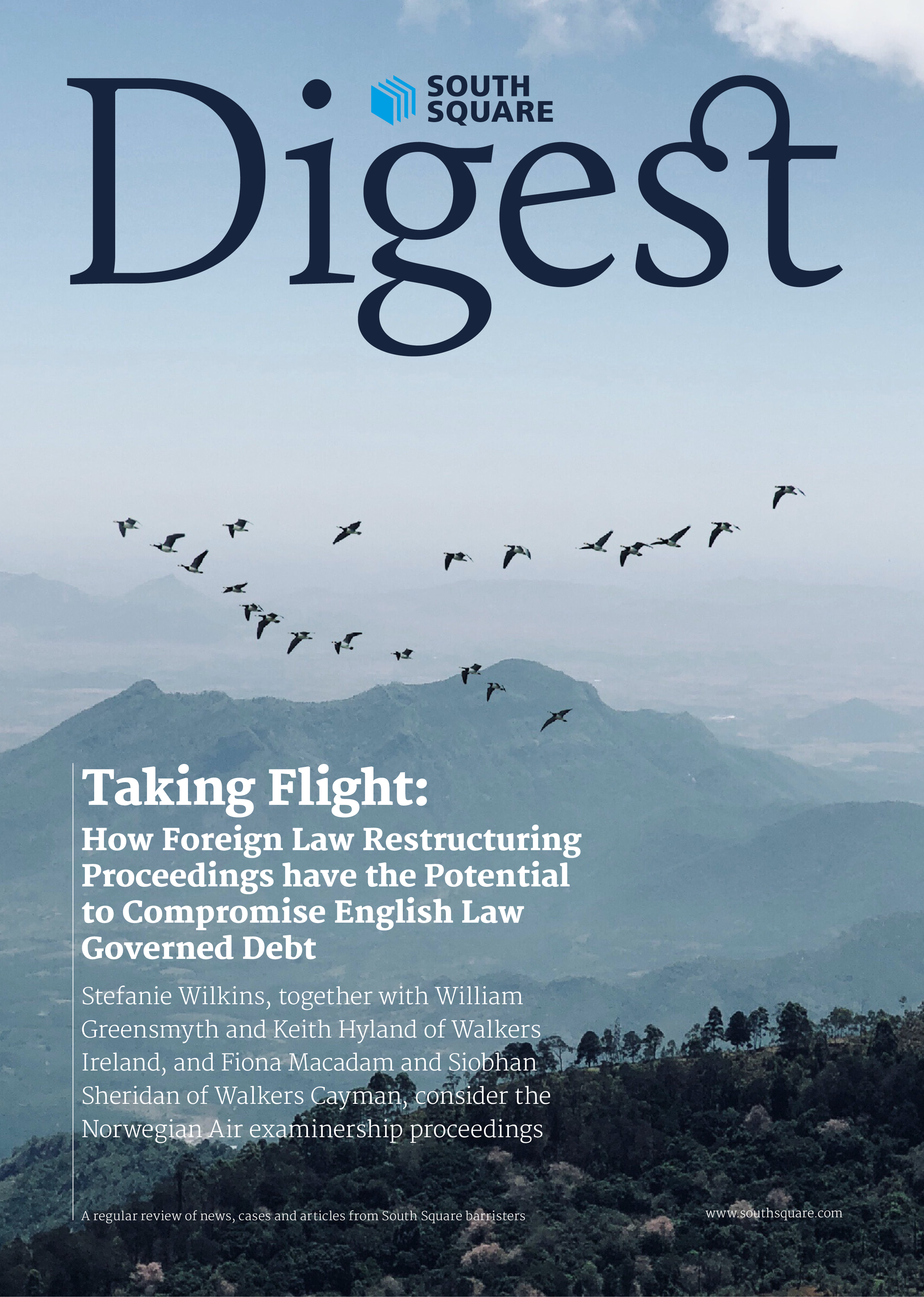

Introduction
A current policy focus for many governments across the world is to strengthen local insolvency systems – and particularly to introduce more flexible rescue processes to maximise the potential for distressed but viable entities to restructure their affairs.
This serves as an important pillar of economic and financial stability – enhancing efficiency, maximising creditor returns, preserving enterprise value and jobs and limiting ‘ripple effects’ that can lead to large-scale financial distress.
In the current difficult economic circumstances, the inherent link between flexible restructuring processes and economic and financial viability and sustainability has become more palpable than in previous years when continued growth had become something of an entrenched norm save for the repercussions which followed the global financial crisis.
More flexible local restructuring processes also help to enhance the appeal of a jurisdiction as an optimal restructuring hub of choice. In turn, this incentivises foreign investment in the jurisdiction. The global economy continues to be marked by a high level of convergence and the conduct of substantial business across borders, notwithstanding the slowdown in trade integration and rising protectionism and economic fragmentation (in part fuelled by rising geopolitical tensions) in recent years.
Indeed, flexible restructuring processes are appealing to creditors because they effectively lower creditors’ risk of loss, with the knowledge that there is a system in place which supports the efficient resolution of competing and complex claims in the event a debtor encounters financial distress. And for debtors, a jurisdiction which offers maximum flexibility, commerciality and pro-restructuring incentives is an important part of long-term business risk planning and sustainability, as well as accessing more affordable finance and investment options.
The United Kingdom has long been regarded as one of the most attractive restructuring venues in the world – a combination of its effective insolvency laws, its strong and respected legal system and judiciary and its status as a business-friendly economic and financial hub.
The desire to retain this position – in the context of the growing appeal of other jurisdictions such as Singapore, the Netherlands, Ireland, Hong Kong, and the Cayman Islands as regional restructuring centres – was a significant motivation for the reforms introduced by the Corporate Insolvency and Governance Act 2020 (UK) (CIGA) in June 2020.
Two of the primary features of the CIGA – the focus of this article – are the standalone moratorium and the restructuring plan.
Measures similar to these restructuring processes are currently being considered in other jurisdictions, including Australia (where two separate consultations are now being pursued with terms of reference that include whether to legislate for a moratorium and whether ‘other improvements to schemes of arrangement could be made’),1 and have come to be seen by policy makers as integral to the design of a best-practice restructuring and insolvency regime. They are currently being introduced throughout the European Union as EU States implement the 2019 EU Directive on Preventive Restructuring Frameworks.2
This article considers whether the United Kingdom reforms have been beneficial, drawing on the March 2022 Interim Evaluation Report
(Interim Report) and the December 2022 Final Evaluation Report (Final Report) commissioned by the United Kingdom Government,3 and whether any adjustments and improvements may be suitable for other jurisdictions seeking to strengthen their own local insolvency systems.
The article will also outline another critical component of establishing an attractive restructuring hub which has long been a feature of the United Kingdom’s insolvency system: progressive and flexible cross-border laws and protocols.
Moratorium
Scope of the moratorium
The CIGA introduced a standalone moratorium in Part A1 of the Insolvency Act 1986 (UK).
The moratorium is intended to facilitate the rescue and restructure of a company as a going concern. It is designed as a standalone pre-formal insolvency moratorium, and does not itself provide for the development and implementation of a formal restructuring plan.
Rather, the moratorium provides a financially distressed company with breathing room from enforcement action and provides it with a payment holiday in relation to most (but not all, as we shall return to consider below) pre-moratorium debts,4 as it investigates its future in negotiations with creditors. The negotiations may lead to an informal out of court workout, or the company may enter into the new standalone restructuring plan introduced by the CIGA or a scheme of arrangement under the Companies Act 2006 (UK) or a formal insolvency process such as a company voluntary arrangement or administration. The moratorium will automatically come to an end if the company enters into any of these processes or goes into liquidation.5
The moratorium is available to ‘eligible companies’,6 a category that excludes certain entities such as banks, insurance companies, electronic money institutions, operators of payment systems, investment banks and investment firms and parties to capital market arrangements. It is a debtor in possession model, under which the company’s directors remain in office and can continue to cause the company to trade, but subject to the oversight of a monitor.
Upon an eligible company’s directors filing the relevant documents with the court, the moratorium is available for an initial 20 business day period.7 This period is then capable of being extended by the company’s directors for up to a further 20 business days without creditor consent.8 The moratorium can also be extended so that it applies for a maximum of 12 months (including the initial 20 business day period) with creditor consent,9 or indefinitely with a court order.10
The moratorium is broad-based and applies to prevent secured creditors (except in relation to the enforcement of a collateral security charge or security arising under a financial collateral arrangement) and unsecured creditors alike, as well as landlords, from enforcing their claims during the moratorium period without the consent of the court.11
The carve-out for financial services
As is well known, the moratorium is subject to a significant carve-out, so that despite restrictions on the enforcement of debts, a monitor has a statutory obligation to bring a moratorium to an end by filing a notice with the court if he or she thinks the company is unable to pay ‘pre-moratorium debts for which the company does not have a payment holiday’ and which have fallen due for payment during the moratorium.12
Among the pre-moratorium debts for which a company does not have a payment holiday are debts and liabilities arising under a contract or other instrument involving financial services,13 which includes loan agreements.
This effectively means that if substantial financiers do not support the moratorium, it will likely need to be terminated so that in reality directors are unlikely to file for a moratorium without the support of such creditors.14 This feature of the moratorium has proven to be a significant limitation to the flexibility of the moratorium and its ability to result in an effective workout. That outcome was noted in the Final Report, with stakeholder views expressed that the inability of a moratorium to ‘prevent a bank from requiring payment of its debt (including accelerated debt)’ is ‘a major reason why it may be of limited use in practice’. Particular concerns were expressed in relation to SME entities:
There is a general perception that the moratorium is more likely to be used by SME companies than large companies, and
many companies in the SME sector have a single main financial creditor (or a small number of such creditors), often their bank.
As the moratorium will not usually prevent the bank from demanding payment of debts due during the moratorium, it is not seen as an effective rescue tool in such cases.
The carve-out for financial services contracts also plainly affects larger enterprises – with the delayed payment of major creditors in a complex and sophisticated financial structure critical to be able to progress restructuring negotiations with a view to the ultimate compromise of the debt.
In considering a best-practice model for other jurisdictions, this is a feature of the moratorium which warrants revision. Removing the carve-out for financial services contracts is likely to provide greater scope for informal workout negotiations, and it would place a distressed entity in the best possible position to preserve its capital and operational structure pending its entry into a formal process such as a scheme or restructuring plan. The company’s inability to meet immediate demands for payment of financial obligations from major financiers in the moratorium could deter the directors from filing for a moratorium in the first place or, if they do so, could cause the early termination of the moratorium and the premature end of restructuring negotiations.
Monitor disincentives
The Interim Report and the Final Report also drew attention to disincentives for a monitor to accept an appointment under the new moratorium.
A key disincentive arises from provisions in Part A1 of the Insolvency Act which state that, if a company fails to pay its moratorium debts and pre-moratorium debts for which it does not have a payment holiday during the moratorium as they fall due, then if the company goes into a subsequent formal insolvency process, the unpaid amounts will have super-priority.
As noted in the Interim Report:
Real concerns were expressed that it would be rare to advise a company to enter into a moratorium … [T]he alteration of priorities in any subsequent administration or liquidation, if the rescue plan is not successful … may have the effect of a subsequent administrator or liquidator not being paid their own fees and expenses … It is therefore the case that a moratorium may not be advisable unless rescue is extremely likely. If a subsequent administration or liquidation is reasonably likely, the altered change in creditor priorities will act as a significant disincentive to use the moratorium.
Additionally, the Final Report identified that there has been a concern among insolvency practitioners about:
Onerous burdens placed upon a monitor as well as potential criminal penalties for actions taken whilst acting as a monitor. The risks facing an IP acting as a monitor appear more significant than, for example, when acting as an administrator.
As noted by the authors in a previous article,15 there is indeed considerable doubt over the extent of investigations expected to be performed by a monitor in coming to the view that a moratorium is likely to result in the rescue of a company as a going concern, and in forming a view about the company’s ongoing ability to meet its required payment obligations. The short time period for which the moratorium lasts, and the intention for the moratorium to be used to lower costs and expenses, points against protracted investigations, but this is not made clear in the legislation, or in the United Kingdom Government’s issued ‘Guidance for Monitors’. With the prospect of personal liability for breach of their duties and responsibilities, the regulatory uncertainty is a deterrent to accepting a monitor appointment.
Eligibility issues
Another significant issue with the moratorium is the eligibility criteria for companies to access the enforcement protections. It was noted in the Interim Report and the Final Report that the current drafting effectively means that the moratorium is not available to mid-market or large companies, as it excludes a company which owes a capital market debt of at least £10 million.
Expanded eligibility seems to be a necessary requirement to enhance the prospect of viable entities being able to restructure their affairs. Excluding a substantial part of the market from accessing the enforcement protections lacks any cogent policy rationale.
Restructuring plan
Design of the restructuring plan
The CIGA introduced a new standalone restructuring plan formal rescue procedure in Part 26A of the Companies Act. Unlike the existing limitations of a company voluntary arrangement, which is not binding on secured creditors without their consent, and a scheme of arrangement, which requires the approval of 75% in value and a majority in number of each class of creditors, the new restructuring plan alternative adopts a ‘cross class cram down’. Each class is deemed to have voted in favour of the plan if 75% by value of that class approve the plan. Unlike a scheme of arrangement, there is no requirement for a majority in number to vote in favour. Provided at least one class has voted in favour, the court can order the plan to become binding on all dissenting classes if none of the dissenting classes would be any worse off than under the ‘relevant alternative’ – being what the court considers would be most likely to occur in relation to the company if the plan was not sanctioned.
Overall effectiveness of the restructuring plan
The Final Report highlighted the success of the restructuring plan since its introduction:
The restructuring plan’s cross-class cram down power has been used successfully in cases where previously a scheme on its own would not have been effective. It is seen as a success as it builds on 150 years of scheme case law and familiarity with that case law breeds confidence in users. The restructuring plan is not seen as a completely new process but is based upon a tried and tested process, with some additional provisions.
DeepOcean16 provided the first opportunity for the English High Court to consider a restructuring plan where the cross-class cram down was being used to bind dissenting unsecured creditors of one of the United Kingdom subsidiaries of the DeepOcean Group. Trower J made an order effecting the cross-class cram down despite only 64.6% of unsecured creditors voting in favour of the plan, on the basis that the unsecured creditors had not provided evidence they would be ‘worse off’ in the event of the ‘relevant alternative’ to the plan – in this case liquidation. There was also no reason for the Court to exercise its discretion to refuse to sanction the restructuring plan on the basis that it was not just and equitable. Relevantly, Trower J identified the material considerations in exercising that discretion, which will be helpful in guiding courts in future cases: the overall support for the restructuring plan across all creditor classes; whether the dissenting class is fairly represented (with a reasonable turnout and no procedural barriers to engagement at a creditors’ meeting); the existence of any collateral interests that influenced voting; and the relative treatment of creditors in different classes (giving rise to questions of ‘horizontal comparability’).
While DeepOcean was a straightforward case, and did not need to canvass complex issues involving class composition and contested ‘relevant alternative’ scenarios, it did still demonstrate the benefit of the new restructuring plan process in the United Kingdom, and the potential for the cross-class cram down to be used to achieve a positive restructuring outcome involving multiple entities within a corporate group in the interests of multiple stakeholders. This outcome would not have been possible prior to the CIGA reforms. There have been a number of cases where the cross-class cram down has been exercised since DeepOcean, and even more where the possibility of cross-class cram down has led to compromises.
Broader restructuring ecosystem
In addition to noting the utility of the the substantive cross-class cram down provisions and the confidence engendered by the fact that the restructuring plans were built on 150 years of case law on schemes of arrangement, the Interim Report and the Final Report noted the importance of the ‘high quality of United Kingdom judges adjudicating on restructuring plans’ as being critical to the success of restructuring plans since their introduction.
This is significant for other jurisdictions considering the adoption of the United Kingdom reforms in an effort to strengthen their own local restructuring processes. Replication of the United Kingdom’s success is not a simple matter of implementing identical laws. Rather, there is a need to build a stronger restructuring ecosystem on a broader level, with institutional capability and expertise to interpret, apply and administer complex laws and factual circumstances.
The importance of creating a ‘restructuring friendly ecosystem’ for a jurisdiction to serve as an attractive restructuring hub was noted in the expert report commissioned by the Singapore Government in 2016 (Singapore Report), which served as the basis for Singapore’s progressive law reforms in 2017 that have seen Singapore since become one of the world’s leading restructuring hubs.
Apart from a skilled judiciary, the Singapore Report also identified the need to focus on ‘strengthening the skills of insolvency professionals’, which could be effected through ‘education, continuing professional development and multi-disciplinary training, to grow this pool and deepen expertise in handling complex cross-border restructuring work’.17
As the World Bank has identified, ‘[e]xpert practitioners, judges and regulators are key to the success of a well-designed insolvency legislation’.18
Singapore has had great success in expanding and strengthening its restructuring ecosystem in recent years. A particularly positive recent innovation has been the establishment of the Singapore International Commercial Court (SICC), and the commencement of the Amended SICC Rules in September 2022, which enable the SICC to exercise jurisdiction in applications for recognition and ancillary relief under the UNCITRAL Model Law on Cross-Broder Insolvency (MLCBI). The Amended Rules also provide for the SICC to make orders for substantive relief where a foreign company has a ‘substantial connection’ with Singapore, and they empower the SICC to order flexible and wide-ranging relief that will drive proactive restructuring outcomes.
Additionally, Judge Sontchi commenced his term as a Judge of the SICC on 4 July 2022. Bringing 16 years of experience as a Judge (and most recently Chief Judge) of the US Bankruptcy Court for the District of Delaware, Judge Sontchi’s appointment strengthens the institutional framework that is the foundation for Singapore’s appeal as a practical, forward-thinking restructuring hub.
Institutional capacity and capability of this kind ought to be a key focus point for other jurisdictions in building more flexible restructuring processes that appeal to local and foreign creditors and are capable of sustaining positive restructuring outcomes.
Possible improvements
The Interim Report and the Final Report highlighted concerns among practitioners that restructuring plans are seen as too costly and time-consuming for use in the small and medium sized enterprise (SME) market.
It was only in July 2022 that the first judgment was delivered in the United Kingdom approving a restructuring plan for a SME (Re Houst Limited).19
The Houst decision shows the potential for courts to take a pragmatic view of the valuation evidence required to support a restructuring plan in the case of a small business – so that the detailed evidence required for larger entities may not be required to the same degree for smaller entities, in light of their simpler affairs and limited resources. This opens the door for SMEs to use the restructuring plan as a viable restructuring tool – without the burden of unrealistic costs and delays.
There may also be cost savings as clearer jurisprudence emerges on the cross-class cram down (so that proceedings become less complicated), and via other measures being explored by R3, the UK Association of Business Recovery Professionals, which is seeking to create examples of restructuring plans dealing with smaller businesses. It might even be feasible, in straightforward cases, for the convening stage of the restructuring plan to be dealt with on papers, therefore avoiding the need for a convening hearing. A court hearing would only then be needed for the sanction stage.
The United Kingdom has a long history of requiring creditors to approve debt arrangements by (at least) a 75% majority in value. Other jurisdictions may see some comparative advantage in reducing such a majority to either a two-thirds or simple majority. Although this issue was touched on in the Interim Report and Final Report, there was no clear consensus for change among the surveyed insolvency profession.
For other jurisdictions, these are important lessons. It is noted that ensuring greater access to flexible restructuring processes for SMEs is a
key recommendation of the World Bank in its Principles for Effective Insolvency and Creditor/Debtor Regimes, and UNCITRAL in its Legislative Guide on Insolvency Law for Micro and Small Enterprises. As the World Bank notes:
SMEs represent over 60% of private sector employment globally and need efficient, cost-effective and nimble [insolvency] systems in order to successfully restructure or exit the market. As SMEs fall into financial difficulty, many face unique challenges dictated by their small size. [Insolvency systems] that do not recognise these challenges, and that are too costly or bureaucratic, make it difficult, if not impossible, for small businesses to use either out of court workouts or more formal tools to reorganise.20
Cross-border processes
While flexible substantive restructuring processes are important as a component of a well-functioning economy and financial system, a jurisdiction’s appeal as a global restructuring hub also ultimately depends on having in place an effective cross-border insolvency system.
As noted in the MLCBI Guide to Enactment and Interpretation, the absence of a consistent, predictable cross-border insolvency system not only ‘results in inadequate and inharmonious legal approaches, which hamper the rescue of financially troubled businesses’ but can also ‘impede capital flow and be a disincentive to cross-border investment’.21
The United Kingdom implemented the MLCBI in
the form of the Cross-Border Insolvency Regulations 2006. The United Kingdom has since become known as one of most forward-thinking jurisdictions in facilitating cross-border cooperation. That said, the United Kingdom continues to apply the so-called rule in Gibbs,22 and this has been argued by some to be capable of undermining the application of modified universalism – the underlying policy aim of modern cross-border insolvency systems.23
Under to the rule in Gibbs, a foreign insolvency process is unable to extinguish or modify a debt owed by the insolvent debtor to a creditor if the debt is governed by English law, unless the creditor voluntarily submits to the jurisdiction in which the foreign proceeding is taking place. The practical effect of the rule is that a foreign restructuring plan that purports to compromise all debts owed by the debtor on a worldwide basis is incapable of binding creditors whose debts are governed by English law and who do not agree to the restructuring plan.
This is not an issue that is dealt with in the MLCBI, which does not expressly require courts to recognise a foreign insolvency judgment, as distinct from a foreign insolvency process.
Other jurisdictions have taken a more expansive approach. For example, in the United States, Judge Glenn held in Re Agrokor:
The basic rationale… in Gibbs – that parties’ consensual, contractual decisions should determine the choice of law of all future
legal interactions – is inappropriate when applied in the context of insolvency or bankruptcy proceedings, which inherently involve a societal choice to allow collective proceedings to discharge previously existing contractual obligations.24
In Singapore, Justice Ramesh in Re Pacific Andes Resources Development Limited concurred, noting:
[A]s bankruptcy law is not and cannot be a consensual matter, the fact that the parties to a contract did not choose the bankruptcy law of a country to discharge contractual obligations is neither here nor there.25
Justice Ramesh proposed an alternative solution so that:
If one of the parties to the contract is the subject of insolvency proceedings in a jurisdiction with which he has an established connection based on residence or ties of business, it should be recognised that the possibility of such proceedings must enter into the parties’ reasonable expectations in entering their relationship, and as such may furnish a ground for the discharge to take effect under the applicable law.26
For jurisdictions seeking to enhance their appeal as a restructuring hub, this is something to which it is worth paying close attention. Application of the rule in Gibbs might deter a jurisdiction’s ability to serve as a ‘lead’ restructuring centre for multi-jurisdictional matters because it would (or at least might) require the costly use of parallel insolvency processes in several jurisdictions rather than being able to use a single restructuring process capable of being recognised in jurisdictions in which the debtor conducts business or in which creditors
are located.27
The ‘next frontiers’ in the cross-border insolvency space are now the adoption and implementation of not just the MLCBI, but also the two new Model Laws on the Recognition and Enforcement of Insolvency-Related Judgments (MLIRJ) and the Model Law on Enterprise Group Insolvency (MLEGI).
If implemented strictly on its terms, the MLIRJ would abrogate the rule in Gibbs pursuant to article 13, which requires an insolvency-related judgment to be recognised and enforced in other jurisdictions, subject to a similar public policy exception that applies under the MLCBI.
The MLEGI is also important in dealing with the complex circumstances of corporate group insolvencies involving assets, debtors and creditors in multiple jurisdictions, currently beyond the scope of the MLCBI. The key feature of the MLEGI is the concept of a ‘planning proceeding’ involving multiple entities under the coordination of a single ‘group representative’.
The United Kingdom Government is currently proposing to adopt the MLIRJ and the MLEGI, albeit in a manner which would give courts the ongoing ability to apply the rule in Gibbs. It is yet to be seen how this will work out in practice.
Modernising cross-border insolvency regulations and protocols, and being seen as a progressive, collaborative and outward facing jurisdiction in facilitating cross-border recognition and harmonisation, is an important policy focus for jurisdictions seeking to strengthen their restructuring processes and build their capability as regional restructuring hubs – just as much as the implementation of substantive laws such as the CIGA moratorium and restructuring plan.
Concluding remarks
The reform process undertaken by the United Kingdom in 2020 – providing for more flexible restructuring options including a standalone enforcement moratorium and a standalone restructuring plan – was important in strengthening the United Kingdom’s broader economic and financial systems, and also in laying the foundation for the United Kingdom to remain as an international restructuring hub of choice.
These reforms serve as a useful model for other jurisdictions currently contemplating improvements to their own restructuring and insolvency processes. Nevertheless, certain modifications could be considered in developing a best practice framework for replication in other jurisdictions.
For the moratorium, these include broader eligibility criteria, so that the moratorium can be used by larger enterprises as well as small to mid-sized entities, as well as removing the carve-out which allows financial creditors to insist on being paid their debts as a condition for the moratorium to continue, and ensuring greater incentives for practitioners to accept appointments as monitors.
For the restructuring plan, streamlined court processes and lesser evidentiary requirements could make a restructuring plan a cost effective and viable option for SMEs as a rescue tool.
At the same time, investing in institutional capacity – with a system of specialised insolvency courts and experienced judges and practitioners – is critical to ensure flexible restructuring processes are capable of interpretation, application and administration in a practical and commercial manner.
Further, while substantive insolvency processes are important, to enhance their appeal as optimal restructuring destinations, jurisdictions need to put in place progressive cross-border insolvency regimes which advance cooperation, coordination, recognition and harmonisation. Particular priority focus points are the adoption and implementation of the MLCBI, the MLIRJ and the MLEGI.
This combination of flexible substantive restructuring processes and progressive cross-border protocols can play a key role in jurisdictions achieving economic and financial stability and long-term investment, innovation, productivity and growth.
1These terms of reference are part of the Australian Treasury’s consultation on ‘improving schemes of arrangement to better support businesses’. Separately, the Parliamentary Joint Committee on Corporations and Financial Services is conducting an inquiry into the ‘effectiveness of Australia’s corporate insolvency laws in protecting and maximising value for the benefit of all interested parties’, including options with reference to ‘international approaches and developments’.
2Directive (EU) 2019/1023 of the European Parliament and of the Council of 20 June 2019 on Preventive Restructuring Frameworks, on Discharge of Debt and Disqualifications, and on Measures to Increase the Efficiency of Procedures Concerning Restructuring, Insolvency and Discharge of Debt.
3The Interim Report and the Final Report were authored by Professor Peter Walton and Dr Lezelle Jacobs from the University of Wolverhampton. In completing these reports, Professor Walton and Dr Jacobs conducted independent research using a ‘mixed methods approach in two stages’. The Interim Report considered data rising from ‘a series of semi-structured interviews of various stakeholders’, while the Final Report considered further interviews and ‘an online survey of the insolvency practitioner profession’.
4Insolvency Act, Part A1, s A18.
5Insolvency Act, Part A1, s A16. In addition, the monitor must bring the moratorium to an end pursuant to s. A38 of the Insolvency Act in specified circumstances by filing notice with the court when the monitor ‘thinks’ that such circumstances exist. In Re Corbin & King Holding Ltd [2022] EWHC 340 (Ch), Sir Alastair Norris adopted the same approach to the interpretation of the word ‘thinks’ as Snowden J in Davey v Money [2018] EWHC 766 (Ch); the monitor’s decision can only be challenged if it is made in bad faith or no reasonable monitor could have made the same decision which provides the monitor with considerable discretion on whether to terminate the moratorium and some protection to the monitor.
6Insolvency Act, Part A1, s A2 and sch ZA1.
7Insolvency Act, Part A1, s A9.
8Insolvency Act, Part A1, s A10.
9Insolvency Act, Part A1, ss A11-A12.
10Insolvency Act, Part A1, s A13.
11Insolvency Act, Part A1, s A21.
12Insolvency Act, Part A1, s A38(1)(d)(ii).
13Insolvency Act, Part A1, s A18(3)(f).
14See also the comment of Sir Alastair Norris in Re Corbin & King Holding Ltd (supra) at [14] that the ‘exclusion of finance debts from the “payment holiday” effects of a moratorium is somewhat surprising’. Sir Alastair goes on to explain at [16] that the purpose of the exclusion was to encourage continued lending to companies who were struggling. The inclusion of such debts in the payment holiday might have been thought otherwise to be something capable of having disincentivised lenders from continuing their support.
15Felicity Toube KC, Hilary Stonefrost, Scott Atkins and Kai Luck, ‘The UK Rescue Moratorium and the Australian SBR: Independence and Investigation Difficulties for Practitioners’, South Square Digest, July 2021, 6.
16[2021] EWHC 138 (Ch).
17Report of the Committee to Strengthen Singapore as an International Centre for Debt Restructuring, 20 April 2016, 4.
18World Bank, ‘World Development Report 2022 – Chapter 3: Restructuring Firm and Household Debt’, 130.
19[2022] EWCH 1941.
20World Bank, ‘Principles for Effective Insolvency and Creditor/Debtor Regimes’, April 2021, Foreword.
21MLCBI Guide to Enactment and Interpretation, 20-21.
22Anthony Gibbs & Sons v La Société Industrielle et Commerciale des Métaux (1890) 25QBD 399.
23There have been changes to the cross-border and restructuring regime in the United Kingdom and Europe as a consequence of Brexit, which mean that recognition of United Kingdom proceedings and judgments in the EU is now less straightforward. The impact of Brexit on UK-EU cross-border restructuring is beyond the scope of this article.
24591 BR 163 (Bankr SDNY 2018), 195.
25[2016] SGHC 210, [47], citing with approval Look Chan Ho, Cross-Border Insolvency: Principles and Practice (Sweet & Maxwell, 2016).
26Idem, [48].
27The case of Re Hong Kong Airlines Ltd [2022] EWHC 3210 (Ch) involved an English restructuring plan which also required a Hong Kong scheme of arrangement as Hong Kong also applies the rule in Gibbs.









![Brake & Anor v The Chedington Court Estate Ltd [2023] UKSC 29](https://southsquare.com/wp-content/uploads/2024/02/Brake-Anor-1-scaled.jpeg)








